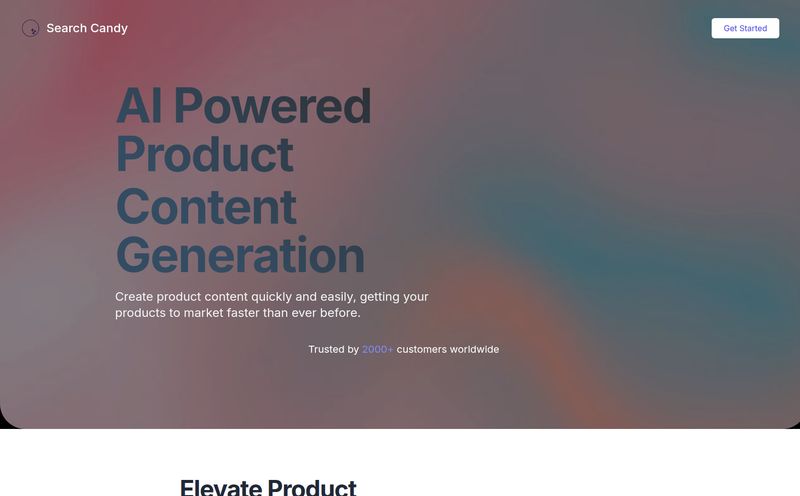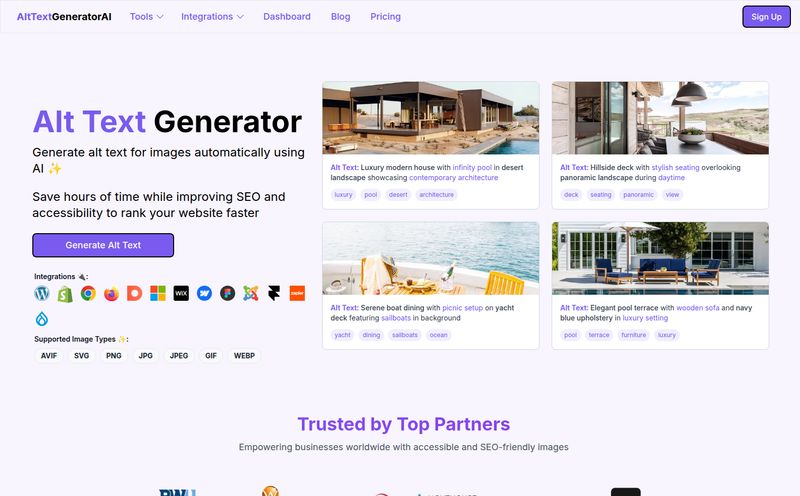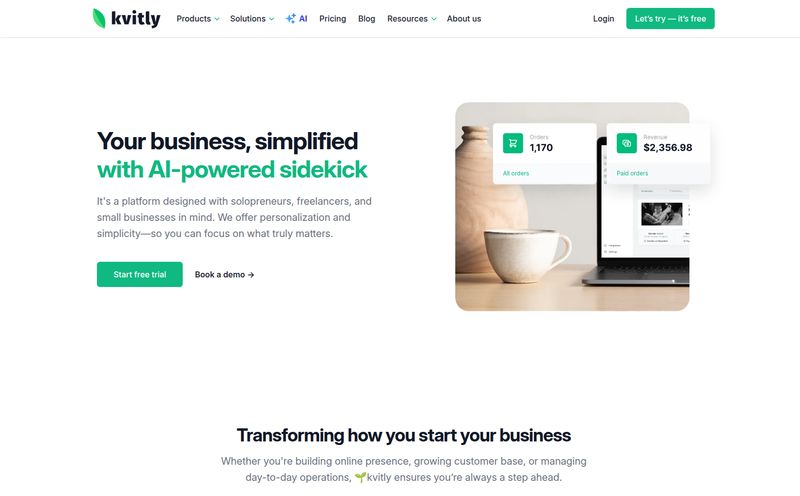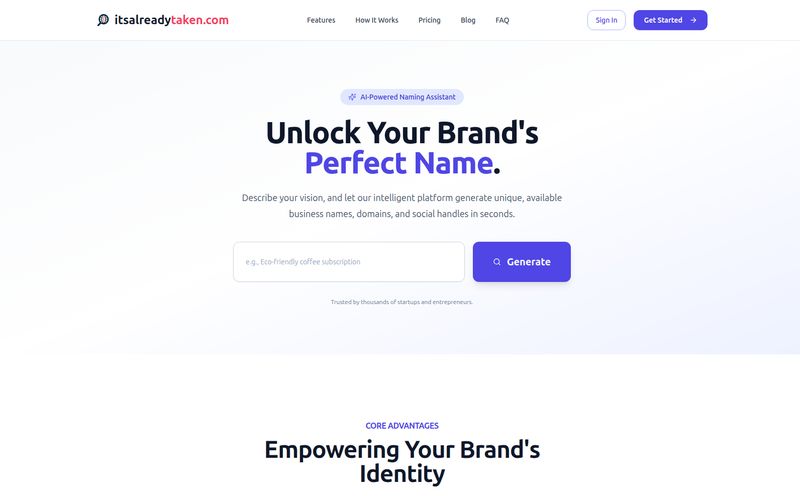Building a website can be a massive pain. I’ve been in the SEO and traffic generation game for more years than I care to admit, and the single biggest groan I hear from small business owners is about getting online. It's the cost, the time, the sheer confusion of it all. You're trying to run a bakery, a plumbing service, or a freelance gig—you don't have time to become a part-time web developer.
We've seen platforms like Wix and Squarespace try to simplify it, and they've done a decent job. But it still feels like work, right? Dragging, dropping, aligning... it's like digital arts and crafts. So when I heard about tools that use AI to do it all for you, my ears perked up. The latest one to cross my desk is called Solo. Its promise is borderline ridiculous: give it your social media page, and it will generate a beautiful, functional website. Instantly. For free.
Sounds too good to be true? Yeah, that's what I thought too. So I decided to put it through its paces.
What Exactly is This Solo Thing?
First off, Solo isn't your typical website builder. It’s less like building with LEGOs and more like using a Star Trek replicator for websites. You don’t pick a template and fill in the blanks. Instead, you feed it an existing online presence—like your company's Facebook page or Yelp profile—and the AI goes to work. It scrapes your info, your photos, your services, your reviews, and constructs a website from that raw material.
The whole idea is to eliminate the setup phase entirely. It’s designed for the business owner who has a solid social media presence but has been putting off the whole website thing. A pretty smart angle, I have to admit.
My First Impressions: Putting Solo to the Test
To give it a fair shake, I grabbed the Yelp page of a local independent coffee shop I like (shoutout to them, you know who you are!). I plugged the URL into Solo and held my breath. And... poof. There it was. A website. It wasn't just a jumble of pictures either; it was a logically laid out, clean-looking site with a hero image, an 'About Us' section pulled from their description, and a gallery of their latte art. It even had a contact form ready to go.
The process took, and I am not exaggerating, less than a minute. It was the kind of speed that makes you question what web developers have been doing with all their time. The design was clean, modern, and most importantly, mobile-friendly right out of the box. I checked it on my phone, and it looked great. No pinching and zooming required.

Visit Solo
The Features That Actually Matter to a Business Owner
An instant website is cool, but is it actually a good website? A site needs more than just a pretty face. It needs to be a tool for growth. This is where I started to dig into the feature list, with my professional skepticism fully engaged.
No Coding? Seriously?
This is a baseline expectation for modern builders, and Solo delivers. There's no code, no FTP, no database nonsense to worry about. For the average small business owner, this is a sigh of relief. It just works.
Free Custom Domain and Hosting? What's the Catch?
Okay, this is where I really raised an eyebrow. Free custom domain connection AND free hosting? This is usually where the 'gotcha' is. Hosting costs money. Domains cost money. In my experience, 'free' often means 'free, but on our ugly subdomain'. But Solo claims you can connect your own domain (e.g., www.yourbusiness.com) for free. This is a huge deal. It's the difference between looking like an amateur and a professional. I'm still a bit curious about their business model, but for the user, this is a massive, massive win.
Built-in SEO: The Claim Every Marketer Scrutinizes
Here we go. My territory. Solo says it adds SEO keywords automatically. As an SEO professional, my internal alarm bells always go off when I hear 'automatic SEO'. It's often snake oil. But let's be fair. What Solo is likely doing is pulling relevant terms from your business category, services, and descriptions to populate meta tags and headings. Is it a replacement for a dedicated SEO strategy? Absolutely not. But is it a million times better than the blank slate you get with a default website build? Yes. It gives you a fighting chance in local search from day one, which is more than many small businesses have.
Social Proof on Autopilot
This feature is genuinely clever. Solo can import your reviews from platforms like Facebook and display them on your site. Social proof is one of teh most powerful conversion tools. Having a system that automatically keeps your best reviews front and center without you having to manually copy-paste them? That's not just a time-saver; it’s a money-maker. It builds trust with potential customers the moment they land on your page.
Okay, But It Can't All Be Sunshine and Rainbows, Right?
No tool is perfect. Every design choice is a trade-off. After the initial 'wow' factor wore off, I did spot a few areas where Solo's approach might be a limitation for some.
The Control Freak's Dilemma
The biggest strength of Solo is also its potential weakness: a reliance on AI for the design. The speed comes from the fact that it makes most of the design decisions for you. If you're a designer, a marketer with very specific brand guidelines, or just a general control freak who wants to nudge a button two pixels to the left, this might drive you crazy. You're trading granular control for convenience. For many, that's a trade they'll happily make. For others, it'll be a deal-breaker.
Diving into the Data
The platform offers its own site analytics, which is great for a quick overview. But the info provided states that for more detailed stats, you might need a Google Analytics account. Honestly, I see this as a positive. Rather than trying to build a second-rate analytics tool, they encourage you to use the industry standard. It shows they know their lane. Every serious business should be using Google Analytics anyway.
Who Is Solo Actually For?
So, after all this, who should drop everything and go try Solo? It's not for everyone, but for a specific group of people, it’s practically a miracle. I've broken it down here.
| This is a great fit for you if... | You might want to look elsewhere if... |
|---|---|
| You're a small local business (cafe, plumber, salon, etc.). | You run a large-scale ecommerce store. |
| You're a freelancer or consultant needing a simple portfolio. | You have a dedicated design team with strict brand rules. |
| You have a good social media presence but no website. | You need complex features like a membership portal or forum. |
| Your budget for a website is currently zero. | You love tinkering and want full creative control. |
The Big Question: Is Solo's Pricing Really Free?
From everything I've seen, yes. The core service of creating and hosting a site, and connecting a custom domain, appears to be completely free. This is the disruptive part. How do they make money? I can only speculate. Perhaps they'll offer premium features in the future—advanced analytics, e-commerce integrations, marketing tools. This freemium model is a classic way to build a user base. Get people in the door with an incredible free offer, and then upsell the power users later. But for now, the value proposition is kind of insane.
Final Thoughts from an Old-School SEO Guy
"For the small business owner who's been procrastinating for years, Solo removes every single excuse. It's not just a tool; it's a solution to a problem that has plagued Main Street for a decade."
So, what's my final verdict? I'm genuinely impressed. Solo isn't going to put high-end web design agencies out of business. It's not meant to. It's a democratization of the web. It lowers the barrier to entry so low that it's practically on the floor. For the small business owner who's been procrastinating for years, Solo removes every single excuse.
It’s fast, it’s easy, and it’s free. In a world full of complex tools and monthly subscriptions, that’s a breath of fresh air. It might not be the perfect solution for every business, but it’s a brilliant solution for many.
Frequently Asked Questions about Solo
Do I need to know how to code to use Solo?
- Absolutely not. That's the whole point. It's a completely code-free experience, designed for people who are experts in their business, not in web development.
Is Solo really free? What about the domain name?
- Based on all available information, the website creation and hosting are free. They also allow you to connect a custom domain that you already own for free, which is a significant perk. You'd still have to purchase the domain name itself from a registrar, which is standard.
Can I sell products through a Solo website?
- The feature set seems heavily focused on service-based and informational websites. It includes a booking system and contact forms, but there’s no mention of a full e-commerce shopping cart. For selling a few items, you could probably embed links to PayPal or another payment processor, but it's not designed to be a Shopify replacement.
How does the AI actually generate the website?
- It uses your existing business information from social media or business directories like Yelp. The AI analyzes your text, images, and business details (like hours and location) to structure a website that is relevant to your industry and content.
Can I edit my website after the AI creates it?
- I would assume basic edits to text and images are possible to keep your site updated. However, the trade-off for the instant creation is likely a limit on major structural or design changes. It's built for speed and simplicity, not for deep customization.
Take the Plunge
Look, I've seen a lot of tools come and go. Most are just variations on a theme. Solo feels a little different. It's taking a genuinely new approach to an old problem. Since it costs nothing to try, my advice is simple: just go for it. If you have a Facebook or Yelp page and five minutes to spare, you can see for yourself. What have you got to lose?



